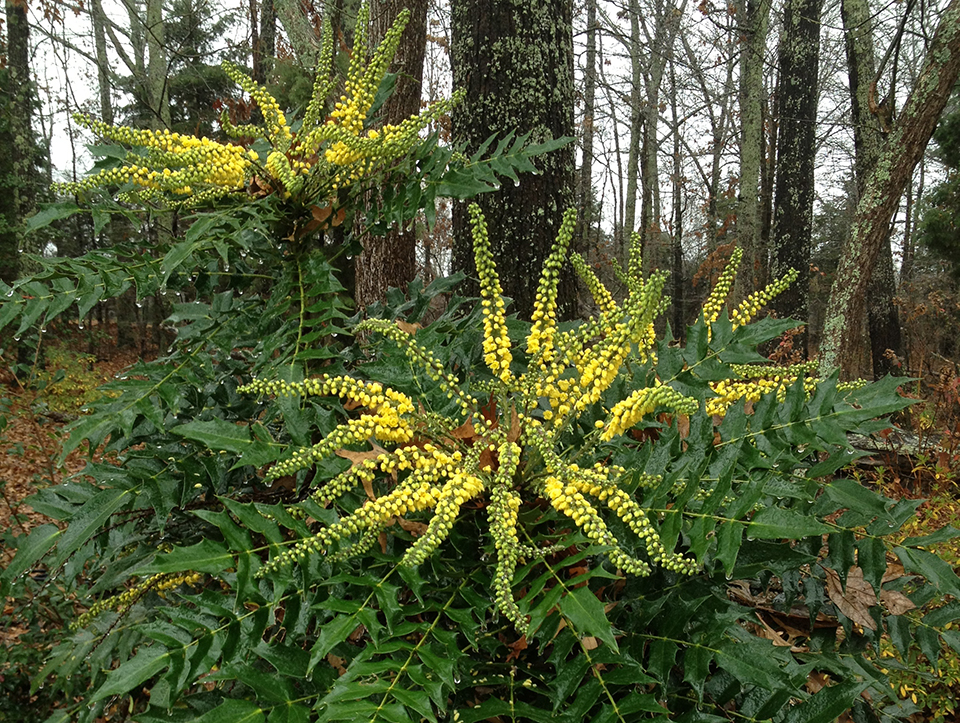
Submitted by Margot Emery, UTIA Department of Marketing and Communications
A wise gardener once wrote that plants are like art — the most popular of either tend not to challenge our notions of beauty or comfort. But if you have a taste for abstract art, then nature has just the plant for you. Meet the leatherleaf mahonia, botanically known as Mahonia bealei.
This erect, evergreen shrub is from China and is a close relative of the barberry. In fact, it’s sometimes called Beale’s barberry and is one of several mahonia species commercially available. With sharp, spiny leaves and a habit of growing in angular, irregular directions, a leatherleaf mahonia makes a wonderful specimen plant in the garden.
Mahonias can add a unique accent to courtyards, Asian-inspired gardens or under high-canopy trees. Their prickly leaves also make an effective barrier. This versatile shrub can also serve as a foundation planting, responding well to pruning that either accents its unusual growth habit or neatens it into a more gentle shape. But beware the reach of its sharp thorns!
In the heart of winter is when leatherleaf mahonias really shine. Their bright, new flower buds capture the eye, and in February spires of vivid yellow flowers open. On warmer days, these blooms offer the first scent of the new season. On sunny days, bees can be seen feasting on its nectar. Winter flowers evolve into sprays of grayish blue berries in early summer. In fall, leaves take on a bronze hue after frost, adding to the seasonal interest throughout the year.
Birds love mahonia berries, and there lies this plant’s PR problem. While some gardeners are passionate about the shrub’s unique beauty, others who are concerned about invasive species cite the plant’s tendency to self-sow and become naturalized. In my yard, new plants rarely occur and are easily removed. The potential for spreading can be avoided entirely by removing berries as they emerge.
Mahonias are highly adaptable and, once established, are quite durable. They prefer a moderately fertile, humus-rich soil that is moist and well drained. They grow in full or part shade, with some able to tolerate sunny locations as long as the soil remains moist. Mahonias can be planted at any time, but spring and summer are ideal because soil is warm and moist. It’s essential to keep new transplants watered, particularly during summer droughts. Their hardiness from USDA zones 6 through 8 makes them ideal throughout Tennessee. Mahonias are slow growers that can ultimately reach heights of 10 to 15 feet if left unpruned but are more commonly seen growing to 6 to 10 feet.
Mahonia ‘Winter Sun’ is an improved hybrid (Mahonia x media) sold in the nursery trade and is grown in the UT Gardens in Knoxville and Jackson. This cultivar has a more compact form and sports abundant yellow flowers that add a cheery note to even the most gray winter day. It is hardy to zones 7 to 9, 6 with protection. ‘Winter Sun’ is known for flowering 6 to 8 weeks earlier than M. bealei.
Margot Emery is a member of the UT Institute of Agriculture Department of Marketing and Communications and writes for the UT Gardens magazine.The UT Gardens includes plant collections located in Knoxville, Jackson and Crossville. Designated as the official botanical garden for the State of Tennessee, the collections are part of the UT Institute of Agriculture. The gardens’ mission is to foster appreciation, education and stewardship of plants through garden displays, educational programs and research trials. The gardens are open during all seasons and free to the public. For more information see http://utgardens.tennessee.edu.
Contacts:
Margot Emery, UT Institute of Agriculture Department of Marketing and Communications, memery@tennessee.edu
Dr. Sue Hamilton, director of the UT Gardens